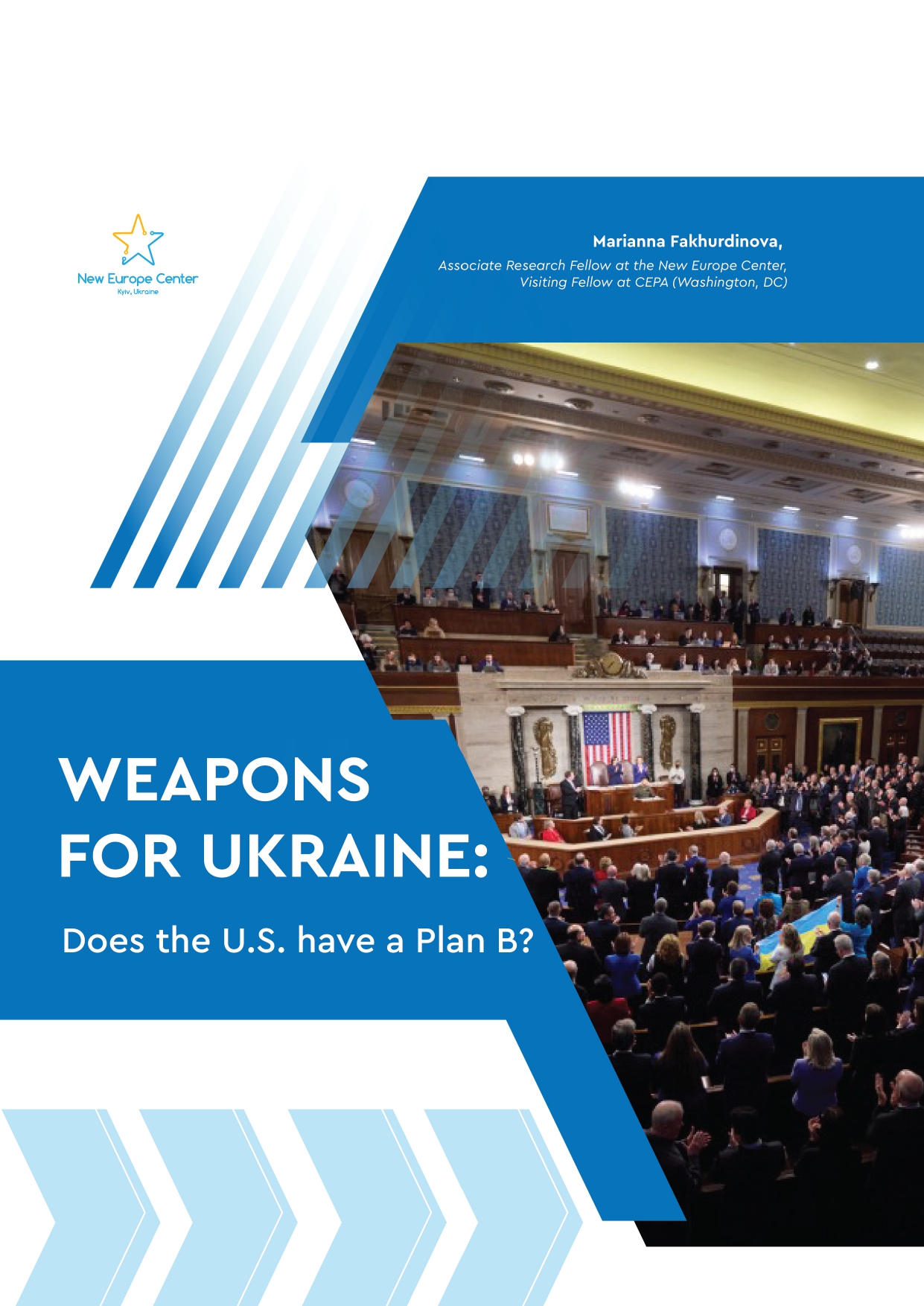
After the U.S. Congress returned from Easter recess on April 9, Speaker of the House Mike Johnson failed to bring up the issue of providing Ukraine with a USD 61 billion aid package (National Security Supplemental Appropriations Act, HR815) for a vote. The U.S. Congress has not been able to pass the bill since October 2023.
Ukrainians have already felt the consequences of political polarization in the United States: due to a lack of ammunition and the inability to defend themselves against Russian attacks with guided aerial bombs, the Ukrainian Armed Forces were forced to withdraw from their positions in Avdiivka in mid-February of the current year. The recent attacks on Ukrainian infrastructure also demonstrate that Ukraine urgently requires a sufficient number of those “damned Patriots” in the front line, as Foreign Minister Dmytro Kuleba put it.
American experts and officials assure that a new aid package will be approved, it is only a matter of time. In particular, during his visit to Kyiv on March 20, White House National Security Advisor Jake Sullivan stated that the United States is not considering a Plan B, as it expects to receive bipartisan support for the aid package for Ukraine. At the same time, the U.S. has already found creative ad hoc solutions to provide additional assistance to Ukraine — a USD 300 million package in March and a batch of small arms to Yemen’s Houthis in April.
The New Europe Center decided to analyze whether the White House has more sustainable alternative ways to provide assistance to Ukraine in case Congress fails to pass a resolution once again. And shouldn’t we start using them now, given the criticality of the situation in Ukraine?
When will American assistance end?
In 2022, the U.S. Congress approved the allocation of more than USD 80 billion in military, financial, and humanitarian aid to Ukraine through four bills on additional funding — Ukraine Supplemental Appropriation Acts. In practice, these funds are managed by a dozen U.S. agencies to provide assistance to Ukraine through various programs. Military assistance has been allocated in the amount of about USD 46 billion, but only a part of it has already reached Ukraine. Assistance is provided in two ways: direct supplies of existing weapons and the production of new ones for Ukraine. Both of them will be discussed below.
- Direct deliveries of existing weapons (short-term assistance)
This way of providing assistance to Ukraine is implemented through the Presidential Drawdown Authority (PDA) program, which allows the White House and the Pentagon to send the existing weapons to Ukraine directly from U.S. warehouses. Since this equipment is available, it arrives in Ukraine quite quickly (the full cycle takes several months). However, the PDA is an authority to use funds, not a funding source. The funds approved by Congress are used to replace the weapons transferred to Ukraine under the PDA by ordering new ones. The United States has been receiving them for years. Since the beginning of the full-scale invasion, the Executive Office of the President has been authorized by the U.S. Congress to send Ukraine USD 26 billion worth of weapons under the PDA. Since then, Ukraine has received USD 20 billion worth of weapons, 1.6 billion have expired because they were not used in fiscal year 2022, and about 4 billion more remain unused.
- Production and procurement of new weapons, as well as repair and re-equipment of old weapons for Ukraine in the United States (long-term assistance)
This process is being implemented through the Ukraine Security Assistance Initiative (USAI), which was specially created for us. Under this program, funds are mostly spent on the purchase of new weapons for Ukraine and remain in the United States. Since February 2022, Congress has allocated about USD 19 billion for USAI. About USD 12 billion of this has already been spent: The U.S. Department of Defense has signed contracts with manufacturers for this amount to produce weapons for Ukraine. However, there is no open data on how many weapons have already been produced and sent to Ukraine. USD 6.6 billion has not even been contracted yet. Since even the contracting process takes years, as well as production and delivery, USAI assistance is designed for a longer term.
Finally, Ukraine has access to the Foreign Military Financing (FMF) program, which is a grant assistance for the purchase of used American weapons or ammunition (carried out through the Foreign Military Sale). It allows Kyiv to choose which weapons to purchase but has a very limited budget (1.6 billion for Ukraine).
Although the White House has reported that almost all the funds to help Ukraine have been exhausted, it will not end anytime soon. After all, it takes months to deliver weapons to Ukraine under the PDA and years to sign contracts for the production of new weapons in the U.S. Therefore, the supply of military equipment to Ukraine from the U.S. has not yet been completed: as for the USAI program, it is only just beginning and will continue for years to come. The problem is that it will be delayed and will not meet the immediate needs of the Ukrainian army.
Option 1: PDA Balances
So why did the provision of assistance to Ukraine effectively stop at the end of December (except for the March package of USD 300 million) if the U.S. has about USD 4 billion in reserve? Given the amount of assistance provided to Ukraine during the first two years of the war, this amount would be enough for about 8–10 new aid packages, which the United States used to announce every two to three weeks, which should have been enough until the U.S. presidential election.
The fact is that the administration does still have the authority to provide Ukraine with about USD 4 billion worth of weapons under the PDA cap, but the Pentagon has run out of real funds to purchase replacement equipment (PDA replenishment). According to defense officials, this was due to an accounting error that was reported in the summer of 2023. Due to the Pentagon’s incorrect calculation of the cost of weapons for Ukraine under the PDA, additional funds were released for appropriations, but the funds for replacement were almost exhausted.
Therefore, as White House officials explain, the administration made a “very difficult decision” to cancel the remaining balance of the PDA in order not to jeopardize the readiness of the U.S. armed forces. The weakness of this argumentation is that replacing the weapons provided to Ukraine is a long process; as of early 2024, the Pentagon had about USD 8 billion in uncontracted money to replenish its own weapons stockpile.
Moreover, the Pentagon could continue to send Ukraine weapons without a guaranteed replacement in the future, as there are no legal requirements to replace equipment sent to partners under the PDA. In addition, the USD 4 billion to help Ukraine is only 0.5% of the Pentagon’s annual budget (USD 850 billion), so it is hardly critical to U.S. national security.
At the very least, until Congress passes a large aid package, the Defense Department could send Ukraine the following items under the PDA, which are in significant stocks and not urgently needed to be replaced. In particular, this refers to cluster munitions for artillery systems (dual-purpose improved conventional munitions, DPICM), of which there are 3 to 4 million in the U.S. Pentagon policy does not recommend the use of DPICMs by U.S. commanders, and a large proportion of them should be decommissioned. The United States began supplying Ukraine with 155-mm DPICM shells in the summer of 2023.
American Bradley infantry fighting vehicles and M113 armored personnel carriers play an important role in fire support, the movement of troops on the battlefield, and the evacuation of the wounded in Ukraine. However, the 186 and 300 units previously sent are not enough, and the civilian alternatives used by Ukraine provide little protection against Russian weapons. Under the PDA, the U.S. can send more of these fighting vehicles and armored personnel carriers: thousands of outdated models are in long-term storage in the U.S. Army, and those still in service are being actively replaced with new ones.
Ultimately, if there is political will, Washington officials can find creative solutions to provide help to Ukraine, even with replacement. In March 2024, the Pentagon managed to find savings to replenish U.S. stockpiles after providing USD 300 million in assistance to Ukraine. According to officials, the savings were due to the fact that certain replacement military goods were purchased at a lower price than originally expected. However, given that the cost of weapons has risen significantly since the full-scale Russian invasion of Ukraine, such explanations raise questions.
Conclusion: Using the balance under the PDA is probably the fastest way to provide assistance to Ukraine. It has already been approved by Congress. It requires political will on the part of the Executive Office of the President and the Department of Defense to temporarily stop replacing weapons for Ukraine in U.S. warehouses. It can meet the immediate needs of the Ukrainian army but is not suitable for a long-term strategy.
Option 2: Excess Defense Articles Program
Another possibility is the Excess Defense Articles (EDA) Program, which is regulated by the Foreign Assistance Act of 1961. It is a mechanism that allows the U.S. Department of Defense to transfer to allied and friendly countries military property that is no longer needed by the U.S. military (partially decommissioned). This is usually done to modernize the armies of partners but primarily the U.S. Army.
This is a profitable deal for the United States, as the recipient country bears the cost of transportation and, if necessary, repairs. The military equipment itself can be transferred to partners on a sale basis (the price is 5–50% of the original cost) or on a free basis (grant). In the case of expiring weapons, their transfer to partners saves American taxpayers money that would otherwise be used for their disposal.
The transfer of arms under the EDA could be a lifeline for Ukraine in the absence of a USD 61 billion package. In particular, the United States could again transfer to Ukraine 155 mm dual-purpose cluster munitions (in particular, M483A1 and M864 DPICM), of which there are about 3–4 million in the U.S. inventory. They are potentially “surplus” because in 2017, the U.S. Army announced the need for new, better-quality ammunition. There is a risk that they will be utilized before the U.S. can make a decision. According to some reports, this process intensified in the summer of 2023, when Ukraine received a share of this ammunition.
According to some experts, the use of the EDA program for Ukraine has its drawbacks. The procedure itself is quite cumbersome: Ukraine has to ask the Pentagon to sell its existing surplus weapons stockpiles, and the Pentagon, in turn, has to notify Congress of its intention to do so, describing the purpose of the transfer, the current and initial value of the property, and an assessment of the impact of the transfer on U.S. military readiness and the U.S. technological and industrial base. In addition, according to the law, the United States may transfer arms to partners under the EDA for a maximum of USD 500 million within one year.
However, the EDA procedure is essentially the same as the USAI procedure already in use. Regarding the EDA budget, the law does not clearly regulate how the Ministry of Defense or the Executive Office of the President should determine the unit price. According to some estimates, the authorities could theoretically set the lowest symbolic price: say, USD 1 for an artillery shell or several thousand dollars for an Abrams tank (M-1A1) or the aforementioned Bradley or M113, of which the United States has thousands in service. With the economic support of European partners, Ukraine could easily cover these and related costs (transportation, repairs, etc.). The main condition is the political will of American and European officials.
Most importantly, the United States already has experience using EDA to transfer military equipment and weapons to Ukraine, both directly and through partners. For example, under this program, the United States sent AH-1Z Viper and UH-1Y Venom helicopters to the Czech Republic and M2 Bradley infantry fighting vehicles to Greece to replace Soviet weapons, which they in turn supplied to Ukraine (the Czech Republic received Soviet Mi-24 helicopters, and Greece received its old fighting vehicles). Under the EDA, the United States also directly transferred Mi-17 helicopters to Ukraine in 2022, Island patrol boats, and military equipment in 2019, 2018, and 2015.
Conclusion: The Pentagon’s ability to make its own decisions on arms transfers to Ukraine, the lack of need to replace them with new ones, and the previous experience of using the EDA program for Ukraine make it an attractive Plan B. Due to its limited budget (USD 500 million per year), it will not be able to provide Ukraine with military assistance in the long term. If there is political will, the flexibility in interpreting the law will allow Kyiv to receive significant amounts of assistance in the short and medium term.
Option 3: Frozen Russian Assets
Another option is to transfer to Ukraine the assets of the Central Bank of the Russian Federation that were frozen in the EU and the U.S. in the first weeks of the full-scale invasion. Overall, we are talking about more than USD 300 billion, of which, however, only a small share is in the United States — according to various estimates, from USD 4 billion to USD 8 billion.
For two years now, there have been discussions about how to implement this plan. From a legal point of view, Ukraine has the right to receive compensation from Russia for the war (UN provisions on the responsibility of states for internationally wrongful acts, the UN doctrine of countermeasures, etc.). However, some partners are concerned about setting an unambiguous precedent and the possible destabilization of the euro and dollar as reserve currencies. Therefore, they expect the G7 and the U.S. to take the lead on this issue.
Recently, in the United States, especially by House Speaker Mike Johnson, there have been more and more references to the REPO for Ukrainians Act. This is a bill on restoring economic prosperity and opportunities for Ukrainians, which gives the United States the authority to confiscate Russian assets under its jurisdiction and transfer them to the needs of Ukraine. However, it is still in its early stages and only received approval from the Senate Committee on Foreign Relations in January 2024. The bill is also supported by the presidential administration.
At the same time, industry experts note that the REPO law will be more symbolic, and the President of the United States already has the right to transfer assets from one country to another under the International Emergency Economic Powers Act (IEEPA). According to the procedure, the head of state can issue an executive order to American banks to transfer the assets of the offending state to a holding account, which will then be transferred to Ukraine under a mechanism agreed upon with partners.
The United States has already used this law to compensate one state for the losses of another. After the Gulf War, U.S. banks froze and later transferred Iraqi assets to the UN Compensation Commission to pay reparations to Kuwait. American presidents have also used the law to unilaterally freeze the assets of third countries: 1979 — Iran, 1988 — Panama, 1998 — Yugoslavia, 2015 — Venezuela, 2021 — Afghanistan.
Finally, the United States can already help use some of Russia’s frozen assets to help Ukraine by encouraging its European partners to be more decisive in this regard. We are talking about the withdrawal of USD 5.2 billion in profits from these assets generated by the Belgian financial company Euroclear for 2022–2023. These funds are already available and can be used right now to provide military support to Ukraine. The United States could show leadership in this matter and encourage its partners to make a decision at the G7 and EU levels.
Conclusion: Designed primarily for the reconstruction of Ukraine, the relatively small frozen Russian assets (4–8 billion) could theoretically be used to purchase weapons for Ukraine. However, this option would require a long time to make a decision on confiscation, develop a compensation mechanism, transfer the assets to Kyiv, and purchase and supply weapons.
Conclusions and Plan A 2.0
Thus, the U.S. assistance has not yet completely ended and will continue to flow to Ukraine for at least a year. The Executive Office of the President has three alternative options to support Ukraine bypassing Congress in the short and medium term. However, their implementation will require additional time, some advocacy efforts, and, most importantly, political will on the part of the White House and the Pentagon.
Providing Ukraine with weapons for the longer term and, at the same time, meeting urgent needs can only be achieved through the implementation of Plan A, i.e., the adoption of a bill to provide a new large package of assistance to Ukraine. However, even the bill for USD 61 billion for Ukraine (HR815) is not a panacea — it provides only about USD 20 billion in military assistance. About 14 billion of these are intended for the production of new weapons under USAI (long-term assistance), and only at best 7 billion are intended to provide Ukraine with existing weapons from warehouses under PDA (immediate needs).
It is not yet known how events in Congress will develop further. Previously, members of the House of Representatives threatened to remove Mike Johnson from the post of Speaker of the House of Representatives, a proposal submitted by Congresswoman Marjorie Taylor Green. If 218 members of the House of Representatives sign a petition for his resignation, they will be able to get a vote, although this procedure will take several weeks.
Before the Easter recess of Congress, Democrats hinted to Johnson that they would support him if he supported Ukraine. Realizing the precariousness of his position, Speaker Mike Johnson said he was ready to do so. However, he promised to introduce his own changes to the law, in particular, to ensure that assistance to Ukraine is provided in the form of a loan. In particular, during his visit to the United States in March, Minister of Justice Denys Malyuska said that Ukraine could receive USD 8.5 billion from the blocked aid package in the form of a loan. In this case, the bill will have to be returned to the Senate for a repeat vote.
According to the latest reports, Johnson failed to reach an agreement with the White House representatives on a modified aid package for Ukraine. The vote on assistance to Ukraine may be postponed for several more weeks.
The author expresses her gratitude to Alik Kasman, Oleh Horenko, and the ProtectUkraineNow project for their assistance in preparing this material.
PDF version is available here.
European Pravda kindly published the media version of analytical article (Ukrainian).
Ukinform kindly published the full version of analytical article (Ukrainian).







